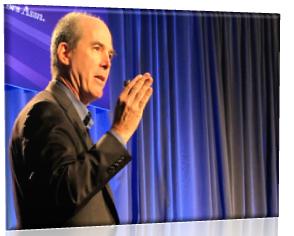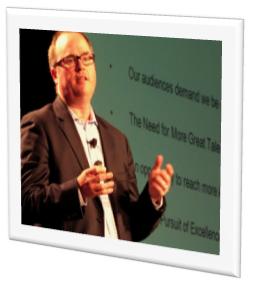 Yesterday, we highlighted NPR’s Kinsey Wilson (at left) and American Public Media’s Dave Kansas (below right), both of whom were featured panelists at a Public Radio Program Directors session moderated by NHPR’s Virginia Prescott in Las Vegas a couple of weeks back.
Yesterday, we highlighted NPR’s Kinsey Wilson (at left) and American Public Media’s Dave Kansas (below right), both of whom were featured panelists at a Public Radio Program Directors session moderated by NHPR’s Virginia Prescott in Las Vegas a couple of weeks back.
Today, I’d like to focus on two big topics from that session: new program development and staffing philosophies, and how they are both being approached in 2012 by two media organizations famous for creating radio programming that garners loyalty and membership support from listeners.
While public and commercial radio have their distinct differences, both of these content gurus offer lessons for everyone working in radio trying to develop new shows and launch new talent. In the case of both NPR and APM, they are dealing with some of the same realities that commercial broadcasters face as heritage shows age out of the system. NPR’s Car Talk will stop producing new shows next month, and A Prairie Home Companion’s Garrison Keillor has flirted with retirement.
 When it comes to launching new programs, Wilson told the public radio audience that the window to prove a show’s value and to build its audience has shrunk. Now they’re thinking more like three years for a new show to firmly establish itself. In commercial radio, of course, there’s even less time.
When it comes to launching new programs, Wilson told the public radio audience that the window to prove a show’s value and to build its audience has shrunk. Now they’re thinking more like three years for a new show to firmly establish itself. In commercial radio, of course, there’s even less time.
This is where new technology comes into play. Kinsey noted that new programs like Ted Talks, Ask Me Another, and Cabinet of Wonders on NPR are examples:
“We’re in a period of transition. We were able to test the ideas and gain audience much more quickly than we have historically done. NPR is not in a position to fund shows for 10 years at a time until they reach the break-even point. The opportunity moving forward is to use the digital arena to more aggressively test concepts.”
And Kansas explained that rather than top-down from the network, new shows like Dinner Party are “coming from the ground up.” And APM uses new technology to “incubate new programming.”
 Another angle is the need for organizations to shift their thinking while working together to share ideas. This is something that Wilson talked about: “Foster an understanding of the space and how we’re going to succeed in it…Get smart people thinking about solutions and give some visibility to lots of really inventive things that are going around in the system.” It also comes down to partnerships, as NPR has sought out an interesting partnership with the creation of its TED Radio Hour.
Another angle is the need for organizations to shift their thinking while working together to share ideas. This is something that Wilson talked about: “Foster an understanding of the space and how we’re going to succeed in it…Get smart people thinking about solutions and give some visibility to lots of really inventive things that are going around in the system.” It also comes down to partnerships, as NPR has sought out an interesting partnership with the creation of its TED Radio Hour.
And in the staffing and hiring dimensions, both Wilson and Kansas acknowledge the change and the adjustments necessary when considering personnel. Wilson contends that “journalists need to be immersed in this changing technology and understand how consumers are using these tools in their daily lives…and not be looked into a particular craft that was invented at a particular time for one purpose.”
And on the topic of hiring “Swiss Army knife journalists,” Kansas noted that when it comes to talent and their skill sets, “You can’t do everything, but more and more people have to do more than one thing very well. If you are going to do only one thing really well, you have to be phenomenal at it.”
Clearly, versatility and multiple skills are more important than ever – as well as the awareness that consumer habits are changing when it comes to media consumption. Finding talent who “gets” that is important to radio – public or commercial.
Most commercial broadcasters simply don’t have opportunities to peak into the public radio window. Thanks to PRPD and Kinsey Wilson and Dave Kansas, we had the chance to do just that.
Thanks to PRPD for the photos.
- Media And Technology In 2025: Believe It Or Not! - April 18, 2025
- In Radio, You Just Never Know - April 17, 2025
- The Secret To Making A Great Podcast (And Great Radio) - April 16, 2025




Leave a Reply